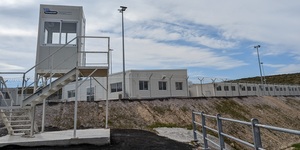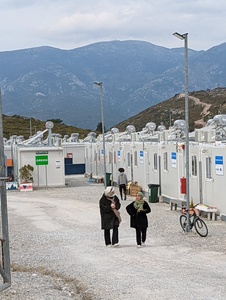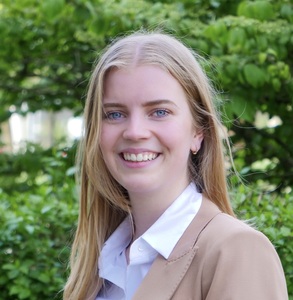A guest post by Veerle Joosen, recent graduate of the Sustainability Science, Policy & Society (SSPS) master’s degree at Maastricht University, whose thesis was supervised by Sonja Fransen, lead researcher of UNU-MERIT’s Comprehensive Innovation Team on Migration.

The Closed Controlled Access Centre in Samos, Greece. Photo: OSCE Parliamentary Assembly
Throughout my teenage years, my passion for sustainability-related issues has driven me to advocate for the well-being of our planet for future generations. In this blog, I outline the motivations behind the research in my master’s thesis.
———————————————————————————————————————————————————————–
Climate change is a complex and global problem with many interlinking social and environmental dimensions. Notably, it is often the poorest and most vulnerable people in the world who are at the forefront of climate change impacts.
This painful reality is what inspires me to work on issues at the intersection of social and environmental sustainability. It is also why, during my undergraduate studies at Tilburg University, my analysis focused on the nexus between climate change and migration. In particular, I took a conceptual approach towards the issue of ‘climate refugees’ and how migration flows, whatever their nature, are influenced by global warming.
For my Sustainability Science, Policy and Society programme master’s thesis, I focused on how climate change impacts pose risks to those who, for various reasons, have already been on the move or displaced. For many populations, climate and extreme weather events pose serious risks, including the increased frequency and intensity of climate and extreme weather events. Within wider climate risk analysis, a focus on asylum-seekers is important because asylum seekers, as a minority community, are more likely to experience climate-related risk often because they live in camps located in remote areas with high exposure to climate hazards. Moreover, these camps often lack dignified living conditions and, in many cases, are not equipped to withstand impacts from climate and extreme weather events.
Analysing the case study
My initial research led me to undertake a case study analysis, exploring the extent to which asylum-seekers face climate risk on the Greek island of Samos. I chose to focus on Greece because thus far, most research on climate risk for asylum seekers focuses on countries outside of the EU. What made the case study particularly interesting is that Samos has hosted a “modern” Closed Controlled Access Centre (CCAC) since September 2021. This centre is funded by the European Commission and, according to the Greek authorities and the EU, was opened with the stated aim to enhance living conditions.
For analysis of my case study, I employed the climate risk framework from the IPCC (2022), which entails three main factors: hazards, exposure, and vulnerability. I added to this framework by applying it to the reality of asylum-seekers, who not only face enhanced vulnerabilities compared to the local population but also face specific vulnerabilities due to their legal status.
The main research question was therefore: “To what extent is the Samos Closed Controlled Access Centre exposed to climate hazards and how vulnerable are its residents to these hazards?”. To address this question, I undertook a document analysis of grey literature and humanitarian reports and interviewed eight experts on the situation in the centre.

The CCAC in Samos, March 2022. Photo: OSCE Parliamentary Assembly
The highlights (or lowest points?)
My results showed that residents of the centre on Samos are mostly exposed to extremely high temperatures, heatwaves, drought, low temperatures, and heavy rainfall. What stood out to me most is that asylum seekers in the centre are vulnerable to these events to a high extent and in a way that is constructed by the location, design, and management of the centre. In particular, the centre is located on a remote hilltop, around eight kilometres from the main town of the island, and bus tickets are unaffordable for many residents. Moreover, the closed structure limits access for humanitarian organisations. This makes it difficult for the centre’s residents to access and secure essential resources.
In addition, the centre is highly securitised and residents face restrictions on their rights to work and freedom of movement. Interviewees stated that the residents feel like they are in prison and that their mental health is impacted by the hostile environment. Due to these factors, residents are made dependent on camp authorities and have less control over their own lives. Therefore, in my thesis, I state that there is a case of “constructed vulnerability”.
Even though asylum-seekers in the CCAC are highly dependent on Greek authorities’ provision of resources, the resources provided to them are insufficient. While living conditions in general are said to have improved, there are, for example, issues with the availability of water, and there are no green spaces available in the centre to provide natural shade to residents. In addition, while the centre provides shelter in the form of containers, there are frequent issues with the heating and air conditioning systems, and as the containers are badly insulated and flammable, they are not hazard-proof. These aspects also make asylum-seekers in the centre more vulnerable to possible climate and extreme weather events. This finding is important because it means that, while the Samos local population is exposed to the same hazards, in case of a climate or extreme weather event, asylum-seekers in the CCAC are likely to be impacted to a larger extent due to their heightened vulnerability.
Of course, it is important to note that some issues in the CCAC lie outside the control of the centre’s authorities. An example is that all of Greece struggles with water scarcity issues.
Moving forward
In conclusion, my research provides insights into the intensified climate risks for asylum seekers residing in camps, particularly related to how a camp’s location, design, and management influences their climate vulnerability. Given that climate change will further increase the frequency and intensity of climate and extreme weather events, it is essential that policymakers take steps to reduce the climate risks facing asylum seekers. The recommendations in my thesis include a focus on:
- A low level of exposure of a camp’s location to climate hazards
- Close proximity of a camp to local communities and resources outside of the camp
- Sufficient availability and accessibility of resources (human, social, natural, physical and financial) – also from within the camp
- Providing space for humanitarian actors in resource and service provision
- Refraining from closed structured camps
By taking these steps, we can help to protect asylum seekers from the climate risks they face, and we can ensure that they have the dignity and support they need to rebuild their lives.
I hope this blog post raises awareness of the climate risks facing asylum seekers and acts as an inspiration for future research.
ANY COMMENTS?
NOTA BENE
The opinions expressed here do not necessarily reflect the views of UNU.
MEDIA CREDITS
Photos “OSCE PA Migration Committee visit to Greece, Samos, Zervou CCAC, 22 March 2022” by OSCE Parliamentary Assembly are licensed under CC BY-SA 2.0 (one has been cropped).




